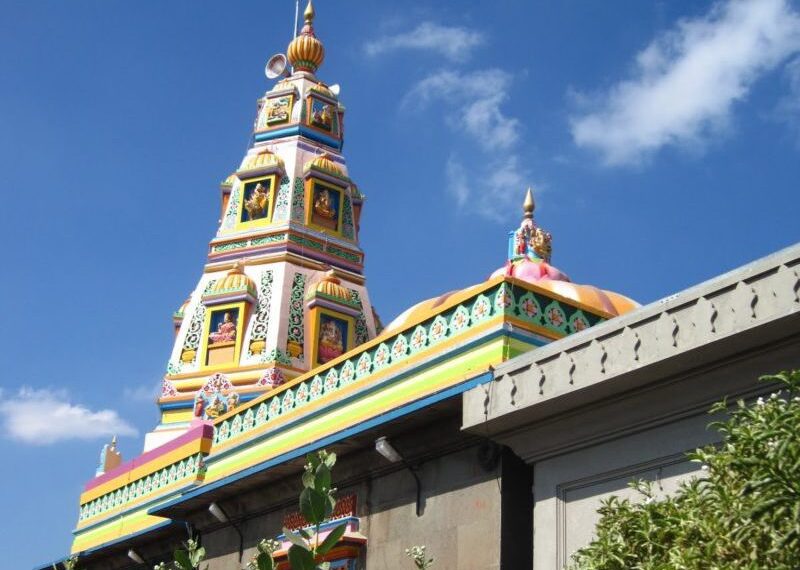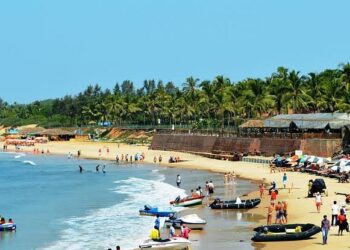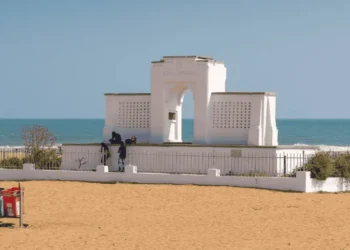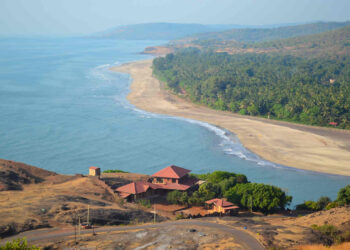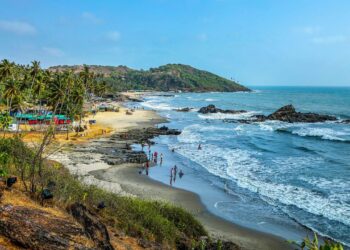Located in Ozar, Pune district, Shri Vighnahar Ganpati temple also known as the Vigneshwara temple is the seventh temple to be visited in the Asthavinayak yatra. Set by the Kukdi River, about 85 km from Pune, the temple is famous for its shiny golden dome (Sonayacha Kalash) at the top. Covering around 1 acre, the temple draws devotees from across India.
Historical Overview
The Vighneshwar Temple is ancient, reaching back to the 14th century, though some say worship began earlier. Ozar, a quiet village 85 km from Pune, was a spiritual spot. Old texts and local talk credit a devotee named Appa Shastri Joshi with building the temple in the early 1700s. The Peshwas, Maratha rulers who revered Ganesha, added halls and walls in the 1700s, as stone writings show. The temple faced damage during invasions in the 1600s, but devotees hid the Ganesha idol in a nearby cave to keep it safe. It was rebuilt in the 1800s with help from local chieftains. From the 1900s, the Endowments Department maintained its sanctity, keeping its old sanctity alive.
Mythological Importance
The Mudgala Purana, Skanda Purana and the Tamil Vinayaka Purana record: King Abhinandana performed a sacrifice in which he did not give any offering to the Devraj Indra. The infuriated Indra ordered Kala (Time/Death) to destroy the sacrifice. Kala takes the form of the demon Vignasura (obstacle-demon) or Vigna (obstacle), who created obstacles in the sacrifice and ruined it. Further, he created havoc in the universe, creating obstacles in the good deeds and sacrifices of sages and other beings. The sages asked god Brahma for help, who advised the worship of Ganesha. Hearing the prayer of the ascetics, Ganesha began to battle the demon and soon defeated it after which it agreed not to harass the beings of the world. It was arranged that Vigna (obstacles) would dwell only in places where Ganesha was not invoked or worshipped. The relieved sages consecrated an image of Ganesha as Vigneshwara at Ozar to mark the event. The temple is for Lord Ganesha, believed to remove obstacles and grant success. His idol, carved from black stone, shows him with his trunk turned left, a rare form, standing for obstacle-destruction and victory.
Temple Structure and Design
The Vighneshwar Temple in Ozar, Maharashtra, is built in the Peshwa architectural style, a refined 18th-century Maratha design that integrates devotion with the village’s natural setting. Situated on a gentle rise near the Kukdi River, the temple stands on a sturdy stone platform with a prominent spire. The entrance, restored in the 1800s, features intricate stone carvings of Ganesha wielding an axe, flanked by celestial attendants and floral motifs within arched borders. Painted in pale saffron and white, the spire is crowned with a polished kalasa that reflects morning sunlight. The sanctum enshrines a black-stone Ganesha idol, adorned with silk cloth and jasmine garlands, placed beneath a silver-plated vimana with a tiered structure symbolizing spiritual ascent. The sanctum’s aged walls bear subtle Peshwa-era inscriptions of Ganesha’s legends, illuminated by ghee lamps.
Encircling the main shrine are smaller altars for Vishnu, Laxmi, and Kartikeya, sculpted from local granite and housed under open pavilions with carved pillars. The Vishnu altar, near the entrance, displays an idol with a discus, its base engraved with wave patterns. The Laxmi altar, in the courtyard, portrays the goddess with gold coins, inviting prayers for prosperity. The Kartikeya altar, opposite Ganesha, depicts him with a spear, representing valor. These altars, though modest, unify the temple’s worship, providing varied avenues for devotion.
A stone pathway from Ozar village, lined with tamarind and mango trees, leads to the temple. The courtyard, laid with polished basalt slabs, maintains a sacred ambiance, shaded by sprawling banyan trees. A ritual pond, connected to the river, features steps with turtle carvings, a hallmark of Peshwa craftsmanship. The temple’s outer walls, constructed from rough stone, include niches for serpent deities, believed to protect the site.
Wall carvings depict Ganesha’s narratives—his creation, his victory over Vighnasur, and his fondness for sweets—designed to guide worshippers. The temple’s architecture focuses on worship, with every element reflecting Ganesha’s sanctity. Repairs in the 1900s strengthened pathways while preserving the temple’s historic and spiritual essence, creating a serene space for prayer.
Rituals and Festivals
The temple celebrates numerous festivals dedicated to Ganesha. Among them, Ganesh Chaturthi in August or September is the grandest, marking Ganesha’s birth, with modak offerings and processions and fasting by devotees.
Information for Travelers
Hours and Entry: Open daily, 5:00 AM to 12:00 PM, then 3:00 PM to 9:00 PM. Entry is free, but rituals cost 50-300 rupees.
Clothing: Wear simple clothes covering shoulders and knees. Men doing rituals wear dhotis and go bare-chested, as custom.
How to Get There:
Air: Pune International Airport, 85 km away, is nearest. Taxis take 2 hours, costing 2000-3000 rupees.
Train: Junnar Railway Station, 10 km away, links to Pune (1 hour) and Mumbai (3 hours). Autos to Ozar cost 200-400 rupees.
Road: Ozar is 85 km from Pune. Buses from Pune’s Shivajinagar Bus Stand (2 hours) stop at Ozar village, 1 km away. Autos cost 20-40 rupees.
Places to Stay: Ozar has plain guesthouses like Bhakta Niwas (500-1000 rupees). Pune, 85 km away, has hotels like Hotel Shreyas (2000-4000 rupees). Stalls by the temple sell dosa, vada, and tea.
Best Time to Visit: October to March has good weather, 20-30°C. Weekdays are calm. Ganesh Chaturthi packs crowds, so book early.
Nearby Attractions: Girijatmaj Temple, 20 km away in Lenyadri, is the seventh Ashtavinayak stop. Shivneri Fort, 15 km away, is Shivaji’s birthplace. Manchar, 30 km away, offers local markets.
